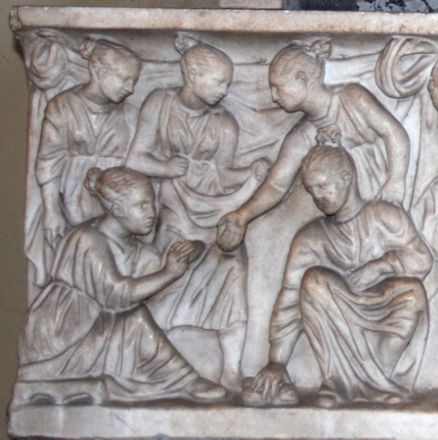
In a grave, on the edge of a Roman battlefield, an ancient sword has been discovered. Legend claims it belonged to King David of Israel and carries a curse—those who wield it will tragically die—but not the chosen.
AD 455. Arria Felix and her husband, Garic the Frank, have safely delivered a sacred relic to Emperor Marcian in Constantinople. But now, Arria and Garic will accept a new mission. The emperor has asked them to carry the sword of King David of Israel to the Church of the Holy Sepulchre in Jerusalem where Arria will dedicate it in her murdered father’s memory.
As Arria and Garic travel into the heart of the Holy Land, they face many challenges and dangers. Their young daughter is missing then found in the company of a strange and suspicious old monk. A brutal killer stalks their path. And a band of cold-blooded thieves is determined to steal the sword for their own gains. But when Arria confronts the question of where the sword should truly rest—old friendships, loyalties, and her duty are put to the test like never before. At every turn, Arria and Garic find themselves caught in a treacherous mission wrapped in mystery, murder, and A Sword Among Ravens.
CHILDREN IN EARLY AND LATE ANCIENT ROME
Writing my series, The Long-Hair Saga, set in late ancient Rome, Gaul, and Jerusalem in the 5th century, has required years of research. My heroine, Lady Arria, is an only child and a Roman senator’s daughter unconventionally educated, beyond the domestic arts and scriptures, because of her exceptional aptitude and interpersonal skills. Her counterpart, Garic, is a Germanic barbarian, Frank noble (known as Long-Hairs), also educated and First Counsel to his tribe. Throughout the series, both heroes encounter social issues that affect their mission, mutual attraction, and the events around them. Caught up in intrigue, politics, mystery, and adventure, they also experience slavery, the exploitation of children, prejudice based on class and ethnicity, religious differences, war, and death. For me, this study has been a fascinating time travel through the lives of my characters and the seed for creating a well-rounded story and world.
Along the way, an area that became interesting to me was the treatment of children and their status. The modern-day view of children’s welfare and status is quite different and, thankfully, much better. Over time, the evolution of parenting within cultural groups and how children are regarded has changed and improved. In modern society, it would be criminal if a parent tried to sell their child. In the ancient world, the sale of a child was not necessarily considered horrific, but rather viewed as benevolent or necessary for that child’s survival in some situations.
How Did the Roman World View Children?

Early Roman views about the status and welfare of children were much different from some of the views held today. Nonetheless, there were laws concerning their status and what was acceptable treatment. Later in the 4th-century Christian Roman world, some laws, practices, and beliefs supported by the Christian church regarding children changed, but many remained in place.
The primary reason for marriage was to produce legitimate children in status as free persons and Roman citizens for the family’s security, which was a core belief. A child born outside of marriage would be of questionable status and inheritance. Within the law, a father would decide within eight days if whether the child would live or ‘be exposed’, which meant death or anonymously taken by another. Some factors regarding a father’s decision included physical and mental defects, legitimacy of the child, or to keep the family small for financial reasons. Boys were favored over girls because they didn’t require dowries and were often considered more productive family members. Another way to produce an heir necessary for the family’s longevity and wealth was through adoption. The adoptee, either adult or child, was then considered the successor.
Raising a child, especially in the early years, was important to parents. Epigraphs and historical medical accounts show that parents, ‘at least among the upper classes,’ had strong parental concerns and emotional attachment. However, according to Geoffrey Nathan in his book The Family in Late Antiquity, after the age of seven was not ‘purely the position of the loved youth’ for a child. Their labor was an investment for the rich and poor. Most of the community was rural, and child labor meant help on farms of various sizes. Urban children, especially the lower classes, had a similar situation within their family professions. If a father or paterfamilias had many male children, it was acceptable to sell them into slavery, or boys and girls could be placed into ‘indentured servitude or apprenticeship, or simply hire them out to a creditor.’
Caring for parents, especially in their older age, was also expected of children. Participating in the family and becoming successors ‘assured a father’s immortality by the transmission of property and by ritual remembrance.’ Children were also responsible for ensuring their parents had a proper burial.
Children of the upper classes were groomed for many responsibilities in either business or public affairs. They must honor their ancestors in the home and on specific holidays. They should marry or divorce at their father’s will. In some cases, a child might object, but it was the father who contracted the marriage. They were also expected to advance the family’s reputation and riches because there was a deep belief in the transmission of property and wealth from one generation to the next. In the law and Roman beliefs, children were under a father’s control and protection. A father was required to behave responsibly towards his children and make sure his daughter married a man who would not abuse her, exact reasonable discipline, and value mercy.
Ancient Roman Views on Discipline

Discipline was different for slave and free-born children. Slaves were more likely to be whipped than free-born children. Experts disagree to what degree whipping or beating was used as a form of discipline. Some authors think it was a form of punishment meant only for slaves to punish certain behaviors. That whipping free-born students was a bad practice, advancing a slave mentality, and ‘It was an affront on a person’s dignitas’and considered a ‘repulsive’ action.
However, according to Nathan, ‘The realities of disciplining a boy (and occasionally a girl) were replete with beatings of every sort.’ Yet Classical authors admonished parents to think and show patience before punishing their children.
In the fourth century and late Christian Empire, some of the practices fully accepted by the society regarding children changed. One of the policies that the church legislated and restated in canon law was restrictions against the sale and exposure of children. Objections to child trafficking reached as far back as the second century.
The practice of selling children or exposure was considered a final action or sale to prevent parents from rashly selling or exposing their children. Now, two canons, nine and ten, in accordance with Honorius’ law, ordered that authorities should take exposed children to a church. If not reclaimed in ten days, they belonged to the finder. Parents who later tried to recover their children would be ‘condemned as murderers’ and the finder ‘slandered.’ The church hoped that the permanence of sale and exposure would keep parents from making hasty decisions.
Generally, the sales of free-born children had been illegal in the early Empire, but in the fourthcentury, Valentinian II permitted this practice on a temporary basis first out of familial need. Later, in the fifth century, Valentinian III allowed it due to a terrible famine that plagued the countryside. Both emperors also enacted measures that provided parents the ability to recover these children easily. However, the policy outlawing or discouraging the barter of free individuals remained.
In the late century, more care was given to the welfare of orphans by the church and securing the freedom of poor free-born children and adults who were bought or stolen by ‘slave traders or kidnapped by barbarians.’ The demand for slaves was high, and their prices were not cheap. ‘For this reason, the government in the sixth century permitted local churches to pawn church property as a guarantee for freeing slaves.’ These actions extended to children and adults. Consequently, children remained in society’s borders, but even more than women, they remained on the edges of society.
In conclusion, historical opinions and views in the late Roman Empire concerning children and the parent-child relationship suggest that parents seemed to pay closer attention to their children’s upbringing. It included personally supervising ‘to correct poor behavior, a strong interest in a child’s basic moral education, and a certain responsibility placed on the parent should that child fail to live up to the expectations of family and society.’ The idea was that the father prepared a child for living in the world, and the mother ‘trained it for the next.’ It appears that as the Empire aged, many things did not change, but the care of the children improved, and Christian parents took greater responsibility for the nurturing of their children.
Resources: The Family in Late Antiquity, Nathan, Geoffrey (Routledge 2000)
Handbook to Life in Ancient Rome, Adkins, Lesley and Roy A. (Oxford University Press 1998)
Amazon UK • Amazon US • Amazon CA • Amazon AU • Barnes and Noble • Kobo
Meet Cynthia Ripley Miller

Cynthia Ripley Miller is a first generation Italian-American writer with a love for history, languages, and books. She has lived in Europe and traveled world-wide, holds two degrees, and taught history and English. Her short fiction has appeared in the anthology Summer Tapestry, at Orchard Press Mysteries.com,and The Scriptor. She is a Chanticleer International Chatelaine Award finalist with awards from Circle of Books-Rings of Honor and The Coffee Pot Book Club. She has reviewed for UNRV Roman History, and blogs at Historical Happenings and Oddities: A Distant Focus and on her website, www.cynthiaripleymiller.com
Cynthia is the author of On the Edge of Sunrise, The Quest for the Crown of Thorns, and A Sword Among Ravens, books 1-3 in her Long-Hair Saga series set in Late Ancient Rome, France, and Jerusalem. Cynthia lives outside of Chicago with her family, along with a cute but bossy cat.
Connect with Cynthia
Website: www.cynthiaripleymiller.com
Facebook: https://www.facebook.com/cynthiaripleymiller/
Twitter: https://twitter.com/CRipleyMiller
Pinterest: https://www.pinterest.com/cripleymiller/ancient-world-fiction/
Amazon: https://www.amazon.com/Cynthia-Ripley-Miller/e/B012P0FJC6
Goodreads: https://www.goodreads.com/book/show/56274617-a-sword-among-ravens
Thank you Cindy for sharing your knowledge about Ancient Rome and the evolution of how children were treated. Very well researched. I guess I should be glad I was born in modern times!
And thank you Mercedes for hosting!
Thank you for hosting my article about children in the ancient world. It’s much appreciated!
Thank you so much for hosting today’s blog tour stop!